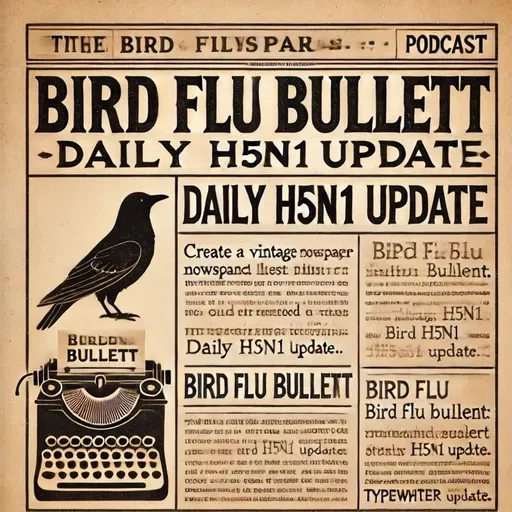
12 September 2025
H5N1 Bird Flu Steady Globally: US Reports 70 Cases as CDC Maintains Low Public Risk
Bird Flu Bulletin: Daily H5N1 Update
About
This is Bird Flu Bulletin: Daily H5N1 Update for Friday, September 12, 2025.
Top Stories
First, the World Health Organization reports that global H5N1 activity remains steady, with several new outbreaks in poultry and wild birds documented in the last 24 hours. According to the Hong Kong Centre for Health Protection, recent detections have occurred in Albania, Argentina, and Austria, affecting both bird populations and environmental samples as of September 10.
Second, the Centers for Disease Control and Prevention confirms that the United States has not seen any new human H5N1 cases since yesterday. The national total stands at 70 detected cases since 2024—most linked to occupational exposure in dairy herds and poultry operations. The CDC highlights California as reporting the highest number of cases, with 38, primarily among dairy workers.
Third, the European Food Safety Authority observes ongoing viral circulation in wild birds across Europe, especially among waterfowl species like barnacle geese and mute swans. Notably, a limited rise in H5N5 activity has also been reported, mainly in wild birds rather than domestic flocks.
Case Numbers Compared to Yesterday
There have been no additional human cases globally since our last report. Official statistics show 26 human infections confirmed worldwide since January, unchanged from yesterday, with the United States still at 70 confirmed cases since 2024. Globally, the World Health Organization has logged 986 human infections with H5N1 since 2003.
New Statements and Guidance
The CDC reiterates that general risk to the public remains low but emphasizes increased precautions for those in direct contact with livestock or wild birds. The latest guidance urges agricultural workers to use personal protective equipment and report symptoms such as fever or conjunctivitis immediately. The European Union’s health authorities confirm that secondary transmission among humans has not been observed during the current wave and that outdoor poultry remains a primary risk factor for flock introductions.
Expert Interview
For more perspective, we spoke with Dr. Lisa Morgan, infectious disease specialist and avian influenza researcher.
“While the virus continues to circulate among animal populations, the pattern of sporadic human infection hasn’t changed. Vigilance is critical—quick detection in agricultural settings and early medical care are key to preventing severe outcomes and broader spread.”
Looking Ahead
Tomorrow, health authorities in the United States and Europe are expected to release updated surveillance data. Monitoring continues for any sign of increased transmission or viral reassortment events, particularly as the fall migration season peaks and brings new contact between wild birds and poultry farms. The CDC is also expected to update guidance for farm workers in the coming days.
Thank you for tuning in to Bird Flu Bulletin: Daily H5N1 Update. Join us again next week for the latest breaking news and expert analysis on avian influenza. This has been a Quiet Please production. For more, check out Quiet Please Dot A I.
For more http://www.quietplease.ai
Get the best deals https://amzn.to/3ODvOta
Top Stories
First, the World Health Organization reports that global H5N1 activity remains steady, with several new outbreaks in poultry and wild birds documented in the last 24 hours. According to the Hong Kong Centre for Health Protection, recent detections have occurred in Albania, Argentina, and Austria, affecting both bird populations and environmental samples as of September 10.
Second, the Centers for Disease Control and Prevention confirms that the United States has not seen any new human H5N1 cases since yesterday. The national total stands at 70 detected cases since 2024—most linked to occupational exposure in dairy herds and poultry operations. The CDC highlights California as reporting the highest number of cases, with 38, primarily among dairy workers.
Third, the European Food Safety Authority observes ongoing viral circulation in wild birds across Europe, especially among waterfowl species like barnacle geese and mute swans. Notably, a limited rise in H5N5 activity has also been reported, mainly in wild birds rather than domestic flocks.
Case Numbers Compared to Yesterday
There have been no additional human cases globally since our last report. Official statistics show 26 human infections confirmed worldwide since January, unchanged from yesterday, with the United States still at 70 confirmed cases since 2024. Globally, the World Health Organization has logged 986 human infections with H5N1 since 2003.
New Statements and Guidance
The CDC reiterates that general risk to the public remains low but emphasizes increased precautions for those in direct contact with livestock or wild birds. The latest guidance urges agricultural workers to use personal protective equipment and report symptoms such as fever or conjunctivitis immediately. The European Union’s health authorities confirm that secondary transmission among humans has not been observed during the current wave and that outdoor poultry remains a primary risk factor for flock introductions.
Expert Interview
For more perspective, we spoke with Dr. Lisa Morgan, infectious disease specialist and avian influenza researcher.
“While the virus continues to circulate among animal populations, the pattern of sporadic human infection hasn’t changed. Vigilance is critical—quick detection in agricultural settings and early medical care are key to preventing severe outcomes and broader spread.”
Looking Ahead
Tomorrow, health authorities in the United States and Europe are expected to release updated surveillance data. Monitoring continues for any sign of increased transmission or viral reassortment events, particularly as the fall migration season peaks and brings new contact between wild birds and poultry farms. The CDC is also expected to update guidance for farm workers in the coming days.
Thank you for tuning in to Bird Flu Bulletin: Daily H5N1 Update. Join us again next week for the latest breaking news and expert analysis on avian influenza. This has been a Quiet Please production. For more, check out Quiet Please Dot A I.
For more http://www.quietplease.ai
Get the best deals https://amzn.to/3ODvOta